Advancement of Green Public Purchasing by Category: Do Municipality Green Purchasing Policies Have Any Role in Japan?
Abstract
1. Introduction
2. Background
2.1. Basic Forms of Japanese Government
2.2. Green Purchasing in Japan
2.3. Questionnaire Survey on Green Procurement by Local Governments
2.4. Summary Statistics
3. Analysis
3.1. Green Purchasing Rate by Category
3.2. Relationship between Green Purchasing Rates and Policies
4. Regression Analysis
4.1. Estimation Model
4.2. Estimation Results
5. Discussion
6. Conclusions
Author Contributions
Funding
Acknowledgments
Conflicts of Interest
Appendix A
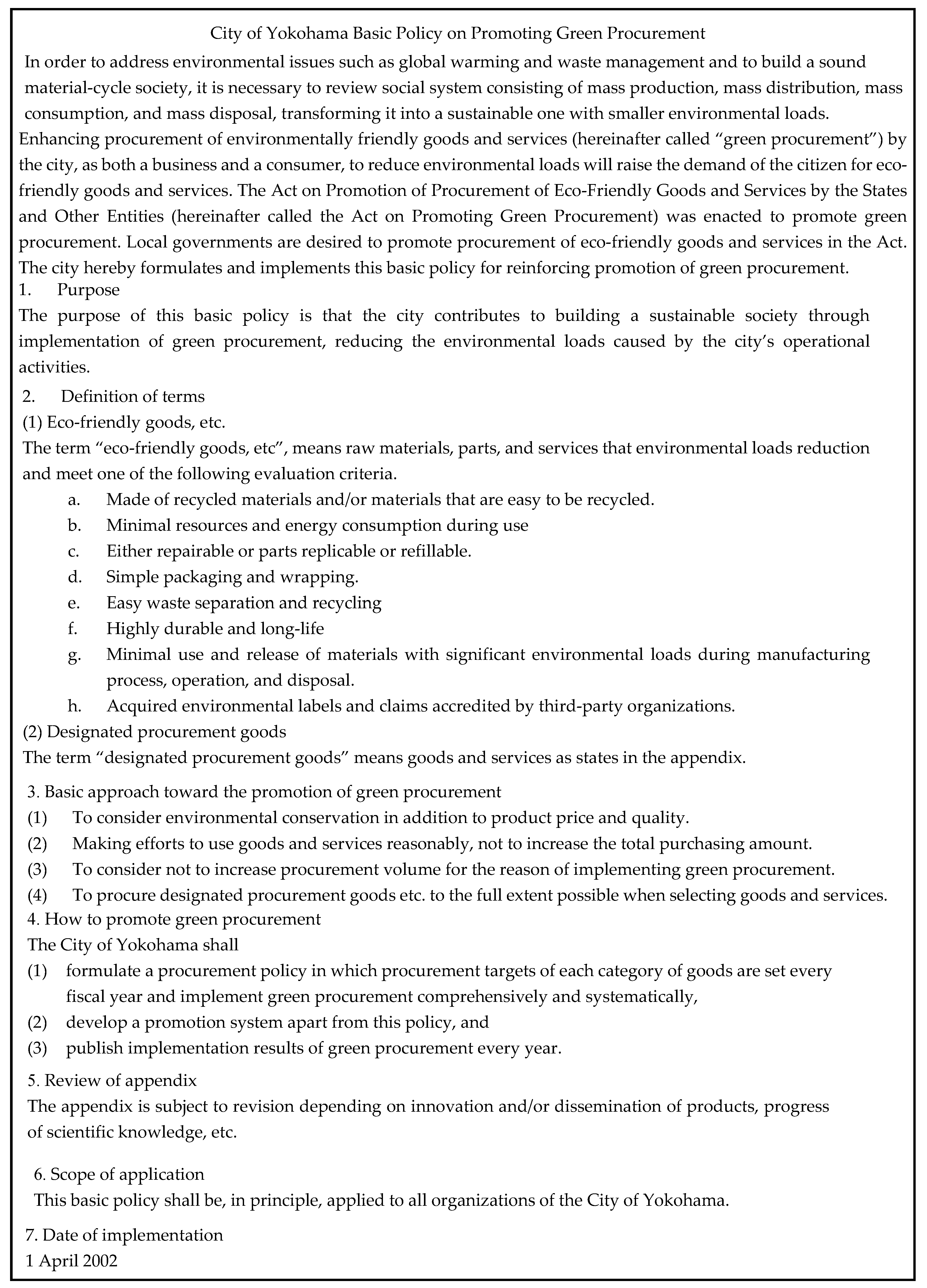
| Categories | Share of Municipalities with a Green Purchasing Policy | Share of Municipalities Measuring Their Own Green Purchasing Rate | ||||||||
|---|---|---|---|---|---|---|---|---|---|---|
| All | with GPP | w/o GPP | Difference | APE | All | with GPP | w/o GPP | Difference | APE | |
| Paper Products | 82% | 97% | 77% | 20% | 0.14 *** | 64% | 75% | 59% | 15% | 0.12 *** |
| obs. | 1629 | 396 | 1229 | 1602 | 1342 | 386 | 952 | 1335 | ||
| Stationery | 76% | 96% | 70% | 26% | 0.19 *** | 44% | 63% | 36% | 27% | 0.23 *** |
| obs. | 1625 | 396 | 1225 | 1598 | 1243 | 380 | 860 | 1238 | ||
| Office Furniture | 58% | 82% | 50% | 32% | 0.17 *** | 27% | 46% | 17% | 29% | 0.25 *** |
| obs. | 1598 | 392 | 1204 | 1592 | 920 | 320 | 598 | 916 | ||
| Imaging Equipment | 57% | 81% | 49% | 32% | 0.18 *** | 25% | 40% | 17% | 24% | 0.22 *** |
| obs. | 1589 | 388 | 1199 | 1583 | 907 | 314 | 591 | 903 | ||
| Electronic Devices | 55% | 79% | 47% | 32% | 0.18 *** | 26% | 44% | 16% | 28% | 0.26 *** |
| obs. | 1584 | 384 | 1198 | 1578 | 870 | 303 | 565 | 854 | ||
| Office Equipment | 59% | 83% | 51% | 32% | 0.19 *** | 28% | 47% | 18% | 28% | 0.28 *** |
| obs. | 1591 | 387 | 1202 | 1585 | 937 | 322 | 613 | 933 | ||
| Mobile Phones | 34% | 44% | 31% | 13% | −0.02 | 11% | 25% | 5% | 20% | 0.21 *** |
| obs. | 1571 | 386 | 1183 | 1565 | 540 | 170 | 368 | 424 | ||
| Home Appliances | 50% | 73% | 43% | 30% | 0.14 *** | 22% | 38% | 12% | 26% | 0.20 *** |
| obs. | 1590 | 388 | 1201 | 1585 | 799 | 284 | 514 | 772 | ||
| Air Conditioner | 47% | 64% | 41% | 24% | 0.06 ** | 20% | 34% | 12% | 22% | 0.16 *** |
| obs. | 1584 | 388 | 1194 | 1578 | 737 | 250 | 485 | 701 | ||
| Water Heaters | 37% | 50% | 33% | 17% | 0.01 | 13% | 28% | 6% | 23% | 0.23 *** |
| obs. | 1573 | 386 | 1185 | 1567 | 588 | 193 | 394 | 454 | ||
| Lighting Equipment | 62% | 83% | 56% | 28% | 0.15 *** | 34% | 49% | 27% | 22% | 0.20 *** |
| obs. | 1602 | 391 | 1208 | 1595 | 999 | 325 | 671 | 994 | ||
| Cars | 64% | 85% | 57% | 27% | 0.14 *** | 42% | 53% | 37% | 16% | 0.12 *** |
| obs. | 1597 | 388 | 1206 | 1590 | 1025 | 329 | 693 | 1020 | ||
| Fire Extinguishers | 49% | 71% | 42% | 29% | 0.12 *** | 24% | 38% | 16% | 22% | 0.19 *** |
| obs. | 1586 | 386 | 1197 | 1579 | 784 | 275 | 506 | 758 | ||
| Uniforms | 55% | 81% | 46% | 35% | 0.18 *** | 32% | 50% | 22% | 28% | 0.20 *** |
| obs. | 1589 | 388 | 1198 | 1582 | 871 | 314 | 555 | 867 | ||
| Bedclothes | 39% | 59% | 32% | 26% | 0.09 *** | 16% | 33% | 6% | 26% | 0.23 *** |
| obs. | 1574 | 384 | 1188 | 1568 | 612 | 225 | 386 | 503 | ||
| Work Gloves | 52% | 76% | 44% | 32% | 0.17 *** | 22% | 41% | 11% | 29% | 0.28 *** |
| obs. | 1592 | 388 | 1201 | 1585 | 824 | 295 | 527 | 777 | ||
| Other Fiber Products | 46% | 64% | 39% | 24% | 0.08 ** | 16% | 33% | 8% | 25% | 0.22 *** |
| obs. | 1580 | 387 | 1190 | 1573 | 719 | 246 | 470 | 659 | ||
| Other Equipment | 44% | 56% | 40% | 17% | 0.03 | 9% | 15% | 7% | 8% | 0.12 *** |
| obs. | 1581 | 386 | 1192 | 1574 | 695 | 218 | 474 | 533 | ||
| Emergency Supplies | 49% | 65% | 43% | 22% | 0.09 *** | 15% | 28% | 9% | 19% | 0.20 *** |
| obs. | 1589 | 386 | 1200 | 1582 | 775 | 251 | 521 | 719 | ||
| Public Works | 50% | 63% | 46% | 17% | 0.04 | 12% | 19% | 8% | 11% | 0.12 *** |
| obs. | 1592 | 387 | 1202 | 1585 | 794 | 242 | 549 | 676 | ||
| Other Public Services | 48% | 63% | 43% | 20% | 0.06 ** | 12% | 24% | 7% | 17% | 0.17 *** |
| obs. | 1587 | 388 | 1196 | 1580 | 768 | 246 | 519 | 652 | ||
| (1) | (2) | |||||||
|---|---|---|---|---|---|---|---|---|
| Implementation of Some Green Purchasing | MEASURING Their Own Green Purchasing Rate | |||||||
| Items | GPP | ln(Population) | ln(SFS) | N | GPP | ln(Population) | ln(SFS) | N |
| Paper Products | 1.74 *** (0.35) | 0.05 (0.24) | 1.15 *** (0.34) | 1602 | 0.58 *** (0.15) | 0.26 (0.21) | −0.11 (0.26) | 1335 |
| Stationery | 1.70 *** (0.28) | 0.34 (0.22) | 0.54 * (0.30) | 1598 | 1.00 *** (0.15) | 0.10 (0.22) | 0.14 (0.27) | 1238 |
| Cars | 0.80 *** (0.18) | 0.20 (0.19) | 0.61 ** (0.26) | 1590 | 0.51 *** (0.15) | −0.00 (0.25) | 0.20 (0.30) | 1020 |
| Lighting Equipment | 0.81 *** (0.17) | 0.30 (0.19) | 0.39 (0.25) | 1595 | 0.92 *** (0.16) | 0.18 (0.26) | −0.15 (0.32) | 994 |
| Office Equipment | 1.05 *** (0.17) | 0.27 (0.20) | 0.54 ** (0.26) | 1585 | 1.43 *** (0.18) | −0.11 (0.30) | 0.25 (0.37) | 933 |
| Office Furniture | 0.90 *** (0.16) | 0.38 * (0.20) | 0.40 (0.26) | 1592 | 1.35 *** (0.18) | −0.08 (0.32) | 0.39 (0.39) | 916 |
| Imaging Equipment | 0.92 *** (0.16) | 0.24 (0.19) | 0.50 ** (0.25) | 1583 | 1.24 *** (0.19) | −0.15 (0.32) | 0.35 (0.39) | 903 |
| Electronic Devices | 0.92 *** (0.16) | 0.24 (0.19) | 0.52 ** (0.25) | 1578 | 1.37 *** (0.19) | −0.05 (0.33) | 0.27 (0.40) | 854 |
| Uniforms | 1.01 *** (0.17) | 0.37 * (0.20) | 0.53 ** (0.26) | 1582 | 1.70 *** (0.22) | −0.40 (0.39) | 0.65 (0.47) | 867 |
| Work Gloves | 0.88 *** (0.16) | 0.32 (0.20) | 0.43 * (0.26) | 1585 | 1.02 *** (0.18) | 0.57 * (0.34) | −0.25 (0.41) | 777 |
| Home Appliances | 0.71 *** (0.15) | 0.08 (0.19) | 0.73 *** (0.25) | 1585 | 1.23 *** (0.21) | −0.44 (0.38) | 0.95 ** (0.46) | 772 |
| Fire Extinguishers | 0.63 *** (0.15) | 0.28 (0.18) | 0.57 ** (0.26) | 1579 | 1.10 *** (0.21) | 0.10 (0.37) | 0.10 (0.45) | 758 |
| Emergency Supplies | 0.41 *** (0.15) | 0.15 (0.19) | 0.42 * (0.24) | 1582 | 1.44 *** (0.25) | −0.35 (0.40) | 0.46 (0.50) | 719 |
| Public Works | 0.17 (0.14) | 0.03 (0.18) | 0.59 ** (0.24) | 1585 | 0.95 *** (0.27) | −0.19 (0.42) | 0.13 (0.53) | 676 |
| Other Public Services | 0.30 ** (0.14) | 0.22 (0.19) | 0.36 (0.24) | 1580 | 1.42 *** (0.28) | −0.87 * (0.47) | 1.13 ** (0.58) | 652 |
| Air Conditioners | 0.31 ** (0.15) | 0.10 (0.20) | 0.71 *** (0.25) | 1578 | 1.07 *** (0.23) | 0.25 (0.43) | 0.09 (0.51) | 701 |
| Other Equipment | 0.13 (0.14) | 0.24 (0.19) | 0.34 (0.25) | 1574 | 1.09 *** (0.32) | −0.63 (0.50) | 0.47 (0.63) | 533 |
| Other Fiber Products | 0.38 ** (0.15) | 0.25 (0.20) | 0.52 ** (0.26) | 1573 | 1.68 *** (0.27) | −0.73 (0.49) | 1.19 ** (0.60) | 659 |
| Bedclothes | 0.45 *** (0.15) | −0.05 (0.21) | 0.94 *** (0.27) | 1568 | 1.79 *** (0.32) | −0.69 (0.57) | 1.37 ** (0.69) | 503 |
| Water Heaters | 0.06 (0.15) | −0.02 (0.20) | 0.78 *** (0.26) | 1567 | 1.79 *** (0.33) | −0.97 * (0.54) | 1.48 ** (0.68) | 454 |
| Mobile Phones | −0.09 (0.15) | 0.03 (0.21) | 0.68 *** (0.26) | 1565 | 1.78 *** (0.38) | −1.22 ** (0.57) | 1.82 ** (0.71) | 424 |
References
- European Commission. Buying Green! A Handbook on Green Public Procurement, 3rd ed.; European Commission: Brussels, Belgium, 2016; ISBN 978-92-79-56848-0. [Google Scholar]
- Grandia, J. Finding the missing link: Examining the mediating role of sustainable public procurement behaviour. J. Clean. Prod. 2016, 124, 183–190. [Google Scholar] [CrossRef]
- Warner, K.E.; Ryall, C. Greener purchasing activities within UK local authorities. Eco Manag. Audit. 2001, 45, 36–45. [Google Scholar] [CrossRef]
- Preuss, L. Buying into our future: Sustainability initiatives in local government procurement. Int. J. Innov. Manag. 2007, 11, 515–537. [Google Scholar] [CrossRef]
- Geng, Y.; Doberstein, B. Greening government procurement in developing countries: Building capacity in China. J. Environ. Manag. 2008, 88, 932–938. [Google Scholar] [CrossRef]
- Walker, H.; Brammer, S. Sustainable procurement in the United Kingdom public sector. Supply Chain Manag. An Int. J. 2009, 14, 128–137. [Google Scholar] [CrossRef]
- Brammer, S.; Walker, H. Sustainable procurement in the public sector: An international comparative study. Int. J. Oper. Prod. Manag. 2011, 31, 452–476. [Google Scholar] [CrossRef]
- Hoejmose, S.U.; Adrien-Kirby, A.J. Socially and environmentally responsible procurement: A literature review and future research agenda of a managerial issue in the 21st century. J. Purch. Supply Manag. 2012, 18, 232–242. [Google Scholar] [CrossRef]
- Ahsan, K.; Rahman, S. Green public procurement implementation challenges in Australian public healthcare sector. J. Clean. Prod. 2017, 152, 181–197. [Google Scholar] [CrossRef]
- Michelsen, O.; de Boer, L. Green procurement in Norway; a survey of practices at the municipal and county level. J. Environ. Manag. 2009, 91, 160–167. [Google Scholar] [CrossRef] [PubMed]
- Testa, F.; Iraldo, F.; Frey, M.; Daddi, T. What factors influence the uptake of GPP (Green Public Procurement) practices? New evidence from an Italian survey. Ecol. Econ. 2012, 82, 88–96. [Google Scholar] [CrossRef]
- Testa, F.; Annunziata, E.; Iraldo, F.; Frey, M. Drawbacks and opportunities of green public procurement: An effective tool for sustainable production. J. Clean. Prod. 2016, 112, 1893–1900. [Google Scholar] [CrossRef]
- Prier, E.; Schwerin, E.; McCue, C.P. Implementation of sustainable public procurement practices and policies: A sorting framework. J. Public Procure. 2016, 16, 312–346. [Google Scholar] [CrossRef]
- Carter, C.R.; Jennings, M.M. The role of purchasing in corporate social responsibility: A structural equation analysis. J. Bus. Logist. 2004, 25, 145–186. [Google Scholar] [CrossRef]
- Zhu, Q.; Geng, Y.; Sarkis, J. Motivating green public procurement in China: An individual level perspective. J Environ. Manag. 2013, 126, 85–95. [Google Scholar] [CrossRef] [PubMed]
- Blome, C.; Hollos, D.; Paulraj, A. Green procurement and green supplier development: Antecedents and effects on supplier performance. Int. J. Prod. Res. 2014, 52, 32–49. [Google Scholar] [CrossRef]
- Günther, E.; Scheibe, L. The hurdle analysis. A self-evaluation tool for municipalities to identify, analyse and overcome hurdles to green procurement. Corp. Soc. Responsib. Environ. Manag. 2006, 13, 61–77. [Google Scholar] [CrossRef]
- Faith-Ell, C.; Balfors, B.; Folkeson, L. The application of environmental requirements in Swedish road maintenance contracts. J. Clean. Prod. 2006, 14, 163–171. [Google Scholar] [CrossRef]
- Parikka-Alhola, K. Promoting environmentally sound furniture by Green Public Procurement. Ecol. Econ. 2008, 68, 472–485. [Google Scholar] [CrossRef]
- Igarashi, M.; de Boer, L.; Michelsen, O. Investigating the anatomy of supplier selection in green public procurement. J. Clean. Prod. 2015, 108, 442–450. [Google Scholar] [CrossRef]
- Sporrong, J.; Bröchner, J. Public procurement incentives for sustainable design services: Swedish experiences. Archit. Eng. Des. Manag. 2009, 5, 24–35. [Google Scholar] [CrossRef]
- Varnäs, A.; Balfors, B.; Faith-Ell, C. Environmental consideration in procurement of construction contracts: Current practice, problems and opportunities in green procurement in the Swedish construction industry. J. Clean. Prod. 2009, 17, 1214–1222. [Google Scholar] [CrossRef]
- Braulio-Gonzalo, B.; Bovea, M.D. Criteria analysis of green public procurement in the Spanish furniture sector. J. Clean. Prod. 2020, 258, 120704. [Google Scholar] [CrossRef]
- Cheng, W.; Appolloni, A.; D’Amato, A.; Qinghua Zhu, Q. Green Public Procurement, missing concepts and future trends—A critical review. J. Clean. Prod. 2018, 176, 770–784. [Google Scholar] [CrossRef]
- Da Ponte, M.; Foley, M.; Cho, C.H. Assessing the degree of sustainability integration in Canadian public sector procurement. Sustainability 2020, 12, 5550. [Google Scholar] [CrossRef]
- United Nations Environment Programme. Global Review of Sustainable Public Procurement 2017. Available online: https://www.unenvironment.org/resources/report/2017-global-review-sustainable-public-procurement (accessed on 15 April 2020).
- Darnall, N.; Stritch, J.M.; Bretschneider, S.; Hsueh, L.; Duscha, M.; Iles, J.; No, W.; Suarez, J.; Burwell, C. Advancing Green Purchasing in Local Governments; Arizona State University, Center for Organization Research and Design, Sustainable Purchasing Research Initiative: Phoenix, AZ, USA, 2017. [Google Scholar]
- Darnall, N.; Arimura, T.H.; Miyamoto, T.; Stritch, J.M.; Bretschneider, S.; Hsueh, L. Advancing Green Purchasing in Japanese Municipalities; Arizona State University, Center for Organization Research and Design, Sustainable Purchasing Research Initiative: Phoenix, AZ, USA; Waseda University, Research Institute for Environmental Economics and Management: Tokyo, Japan, 2018. [Google Scholar]
- Leal, A.R.; Pérez-Castillo, D.; Husted, B.W.; Amorós, E. Advancing Green Purchasing in Mexican Municipalities; Arizona State University, Center for Organization Research and Design, Sustainable Purchasing Research Initiative: Phoenix, AZ, USA; Tecnológico de Monterrey, EGADE Business School: San Pedro Garza García, Mexico, 2019. [Google Scholar]
- Cities Designated by Government Ordinance of Japan. Wikipedia. Available online: https://ja.wikipedia.org/wiki/%E6%94%BF%E4%BB%A4%E6%8C%87%E5%AE%9A%E9%83%BD%E5%B8%82 (accessed on 27 October 2020).
- Thomson, J.; Jackson, T. Sustainable procurement in practice: Lessons from local government. J. Environ. Plan. Manag. 2007, 50, 421–444. [Google Scholar] [CrossRef]
- Ministry of the Environment. Achievements of Green Purchasing by the National Institutions and Their Environmental Impact Reduction Effects, etc. (In Japanese). Available online: https://www.env.go.jp/policy/hozen/green/g-law/jisseki/reduce-effect_h29.pdf (accessed on 27 October 2020).
- Ministry of the Environment. Act on Promoting Green Procurement. Available online: https://www.env.go.jp/policy/hozen/green/attach/gpp%20pamphlet_eng.pdf (accessed on 15 April 2020).
- Promotion of Green Purchasing. Webpage of City of Yokohama. (In Japanese). Available online: https://www.city.yokohama.lg.jp/kurashi/machizukuri-kankyo/ondanka/etc/shiyakusho/green.html (accessed on 15 April 2020).
- Von Oelreich, K.; Philip, M. Green Public Procurement—A Tool for Achieving National Environmental Quality Objectives; Swedish Environmental Protection Agency: Stockholm, Sweden, 2013.
- IR document by Budget Division. Bureau of Finance Tokyo Metropolitan Government. 2019. Available online: https://www.zaimu.metro.tokyo.lg.jp/bond/en/ir_library/ir/ir_document2019_Nov.pdf (accessed on 16 April 2020).
- Handfield, R.; Sroufe, R.; Walton, S. Integrating environmental management and supply chain strategies. Bus. Strategy Environ. 2005, 14, 1–19. [Google Scholar] [CrossRef]
- Kjöllerström, M. Public Procurement as a tool for promoting more sustainable consumption and production patterns. Sustain. Dev. Innov. Briefs. 2008, 1, 1–12. [Google Scholar]
- Giunipero, L.; Handfield, R.B.; Eltantawy, R. Supply management’s evolution: Key skill sets for the manager of the future. Int. J. Oper Prod. Manag. 2006, 26, 702–714. [Google Scholar] [CrossRef]
- Sarkis, J.; Gonzalez-Torre, P.; Adenso-Diaz, B. Stakeholder pressure and the adoption of environmental practices: The mediating effect of training. J. Oper. Manag. 2010, 28, 163–176. [Google Scholar] [CrossRef]
- Tassabehji, R.; Moorhouse, A. The changing role of procurement: Developing professional effectiveness. J. Purch. Supply Manag. 2008, 14, 55–68. [Google Scholar] [CrossRef]
- Mosgaard, M.; Riisgaard, H.; Huulgaard, R.D. Greening non-product-related procurement—When policy meets reality. J. Clean. Prod. 2013, 39, 137–145. [Google Scholar] [CrossRef]
- Grandia, J.; Voncken, D. Sustainable Public Procurement: The Impact of Ability, Motivation, and Opportunity on the Implementation of Different Types of Sustainable Public Procurement. Sustainability 2019, 11, 5215. [Google Scholar] [CrossRef]
- Ogunsanya, O.A.; Aigbavboa, C.O.; Thwala, D.W.; Edwards, D.J. Barriers to sustainable procurement in the Nigerian construction industry: An exploratory factor analysis. Int, J. Constr. Manag. 2019. [Google Scholar] [CrossRef]
- Mendoza Jiménez, J.; Hernández López, M.; Franco Escobar, S.E. Sustainable Public Procurement: From Law to Practice. Sustainability 2019, 11, 6388. [Google Scholar] [CrossRef]
- Min, H.; Galle, W.P. Green purchasing practices of US firms. Int. J. Oper. Prod. Manag. 2001, 21, 1222–1238. [Google Scholar] [CrossRef]
- Stritch, J.M.; Bretschneider, S.; Darnall, N.; Hsueh, L.; Chen, Y. Sustainability Policy Objectives, Centralized Decision Making, and Efficiency in Public Procurement Processes in U.S. Local Governments. Sustainability 2020, 12, 6934. [Google Scholar] [CrossRef]
- AlNuaimi, B.K.; Khan, M. Public-sector green procurement in the United Arab Emirates: Innovation capability commitment to change. J. Clean. Prod. 2019, 233, 482–489. [Google Scholar] [CrossRef]
- Glas, A.H.; Schaupp, M.; Essig, M. An organizational perspective on the implementation of strategic goals in public procurement. J. Public Procure. 2017, 17, 572–605. [Google Scholar] [CrossRef]
- Oruezabala, G.; Rico, J.-C. The impact of sustainable public procurement on supplier management—The case of French public hospitals. Ind. Mark. Manag. 2012, 41, 573–580. [Google Scholar] [CrossRef]
- Rahman, S.; Subramanian, N. Factors for implementing end-of-life computer recycling operations in reverse supply chains. Int. J. Prod. Econ. 2012, 140, 239–248. [Google Scholar] [CrossRef]
- Boros, A.; Fogarassy, C. Relationship between Corporate Sustainability and Compliance with State-Owned Enterprises in Central-Europe: A Case Study from Hungary. Sustainability 2019, 11, 5653. [Google Scholar] [CrossRef]
- Davies, A. The Law of Green and Social Procurement in Europe; Sweet MaxwellL Ltd.: North Way, UK, 2011. [Google Scholar]
- Kaiser, B.; Eagan, P.D.; Shaner, H. Solutions to health care waste: Life-cycle thinking and "green" purchasing. Environ. Health Perspect. 2001, 109, 205. [Google Scholar] [CrossRef]
- Worthington, I. Corporate perceptions of the business case for supplier diversity: How socially responsible purchasing can ‘pay’. J. Bus. Ethics 2009, 90, 47–60. [Google Scholar] [CrossRef]
- Seuring, S.; Müller, M. From a literature review to a conceptual framework for sustainable supply chain management. J. Clean. Prod. 2008, 16, 1699–1710. [Google Scholar] [CrossRef]
- Vluggen, R.; Gelderman, C.J.; Semeijn, J.; van Pelt, M. Sustainable Public Procurement—External Forces and Accountability. Sustainability 2019, 11, 5696. [Google Scholar] [CrossRef]
- Vigerstol, K.L.; Aukema, J.E. A comparison of tools for modeling freshwater ecosystem services. J. Environ. Manag. 2011, 92, 2403–2409. [Google Scholar] [CrossRef] [PubMed]
- Gualandris, J.; Kalchschmidt, M. Customer pressure innovativeness: Their role in sustainable supply chain management. J. Purch. Supply Manag. 2014, 20, 92–103. [Google Scholar] [CrossRef]
- Lee, S.-Y. Drivers for the participation of small and medium-sized suppliers in green supply chain initiatives. Supply Chain Manag. J. 2008, 13, 185–198. [Google Scholar] [CrossRef]
- Seuring, S. A review of modeling approaches for sustainable supply chain management. Decis. Support Syst. 2013, 54, 1513–1520. [Google Scholar] [CrossRef]
- Vachon, S.; Klassen, R.D. Extending green practices across the supply chain: The impact of upstream downstream integration. Int. J. Oper. Prod. Manag. 2006, 26, 795–821. [Google Scholar] [CrossRef]
- Bala, A.; Munoz, P.; Rieradevall, J.; Ysern, P. Experiences with greening suppliers the universitat autonoma de Barcelona. J. Clean. Prod. 2008, 16, 1610–1619. [Google Scholar] [CrossRef]
- Xu, S.; Chu, C.; Ju, M.; Shao, C. System Establishment and Method Application for Quantitatively Evaluating the Green Degree of the Products in Green Public Procurement. Sustainability 2016, 8, 941. [Google Scholar] [CrossRef]
- Soto, T.; Escrig, T.; Serrano-Lanzarote, B.; Matarredona Desantes, N. An Approach to Environmental Criteria in Public Procurement for the Renovation of Buildings in Spain. Sustainability 2020, 12, 7590. [Google Scholar] [CrossRef]
- Montalbán-Domingo, L.; Aguilar-Morocho, M.; García-Segura, T.; Pellicer, E. Study of Social and Environmental Needs for the Selection of Sustainable Criteria in the Procurement of Public Works. Sustainability 2020, 12, 7756. [Google Scholar] [CrossRef]
- Lam, T.Y.M. A sustainable procurement approach for selection of construction consultants in property and facilities management. Facilities 2019, 38, 98–113. [Google Scholar] [CrossRef]
- Laosirihongthong, T.; Samaranayake, P.; Nagalingam, S. A holistic approach to supplier evaluation and order allocation towards sustainable procurement. Benchmarking 2019, 26, 2543–2573. [Google Scholar] [CrossRef]
- Sparrevik, M.; Wangen, H.F.; Fet, A.M.; De Boer, L. Green public procurement—A case study of an innovative building project in Norway. J. Clean. Prod. 2018, 188, 879–887. [Google Scholar] [CrossRef]
- De Filippo, D.; Sandoval-Hamon, L.A.; Casani, F.; Sanz-Casado, E. Spanish Universities ’Sustainability Performance and Sustainability-Related R&D + I. Sustainability 2019, 11, 5570. [Google Scholar]
- Rietbergen, M.G.; Blok, K. Assessing the potential impact of the CO2 Performance Ladder on the reduction of carbon dioxide emissions in The Netherlands. J. Clean. Prod. 2013, 52, 33–45. [Google Scholar] [CrossRef]
- Simcoe, T.; Toffel, M.W. Government green procurement spillovers: Evidence from municipal building policies in California. J. Environ. Econ. Manag. 2014, 68, 411–434. [Google Scholar] [CrossRef]
- Brusselaers, J.; Van Huylenbroeck, G.; Buysse, J. Green Public Procurement of Certified Wood: Spatial Leverage Effect and Welfare Implications. Ecol. Econ. 2017, 135, 91–102. [Google Scholar] [CrossRef]
- Islam, M.M.; Turki, A.; Murad, M.W.; Karim, A. Do Sustainable Procurement Practices Improve Organizational Performance? Sustainability 2017, 9, 2281. [Google Scholar] [CrossRef]
- EU Commission. Public Procurement for a Circular Economy: Good Practice and Guidance. Available online: http://ec.europa.eu/environment/gpp/pdf/Public_procurement_circular_economy_brochure.pdf (accessed on 12 September 2020).
- Lăzăroiu, G.; Ionescu, L.; Uță, C.; Hurloiu, I.; Andronie, M.; Dijmărescu, I. Environmentally Responsible Behavior and Sustainability Policy Adoption in Green Public Procurement. Sustainability 2020, 12, 2110. [Google Scholar] [CrossRef]
- Witjes, S.; Lozano, R. Towards a more circular economy: Proposing a framework linking sustainable public procurement and sustainable business models. Resour. Conserv. Recycl. 2016, 112, 37–44. [Google Scholar] [CrossRef]
- Alhola, K.; Ryding, S.-O.; Salmenperä, H.; Busch, N.J. Exploiting the potential of public procurement: Opportunities for circular economy. J. Ind. Ecol. 2019, 23, 96–109. [Google Scholar] [CrossRef]
- Sönnichsen, S.D.; Clement, J. Review of green and sustainable public procurement: Towards circular public procurement. J. Clean. Prod. 2020, 245, 118901. [Google Scholar] [CrossRef]
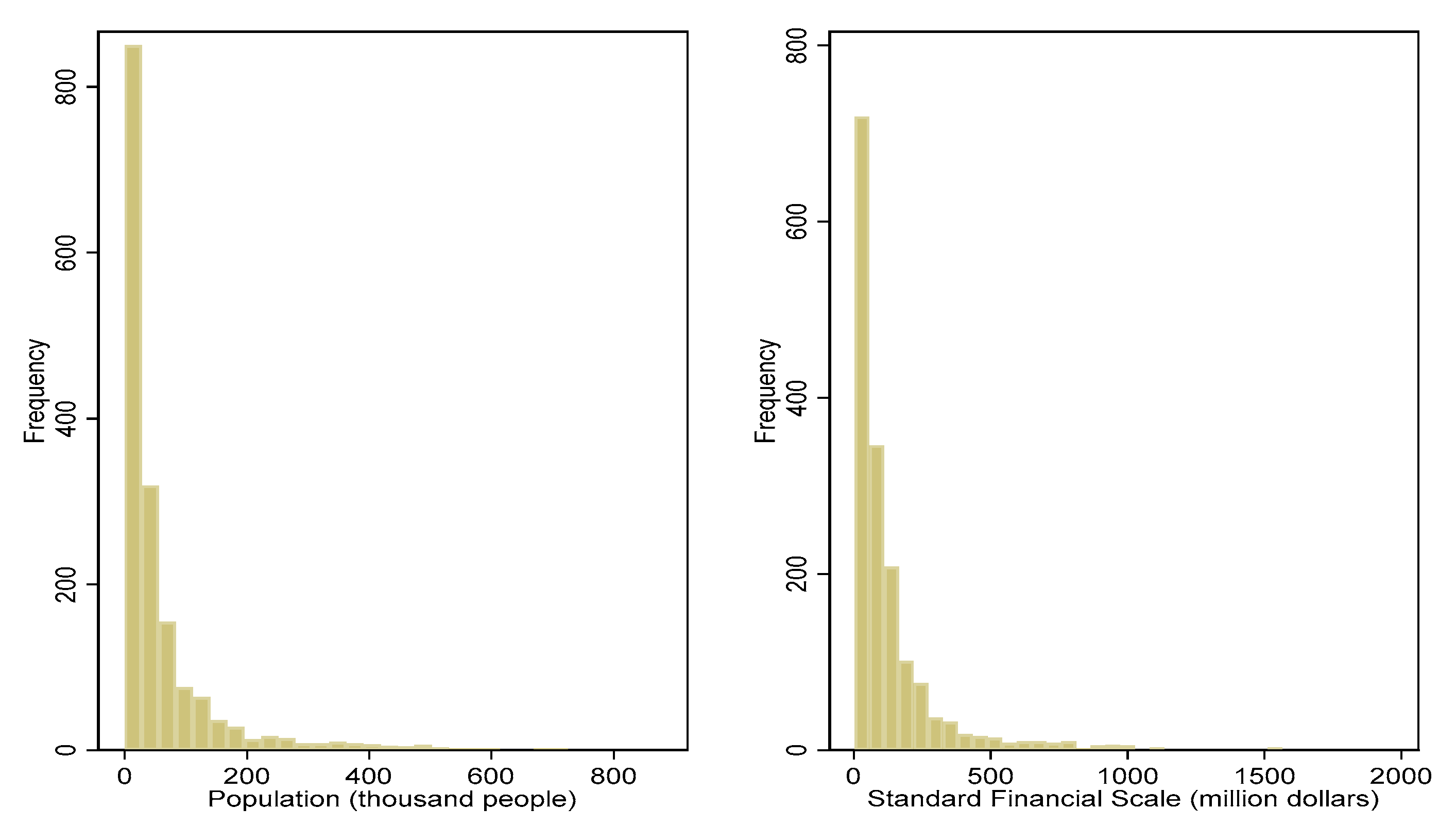
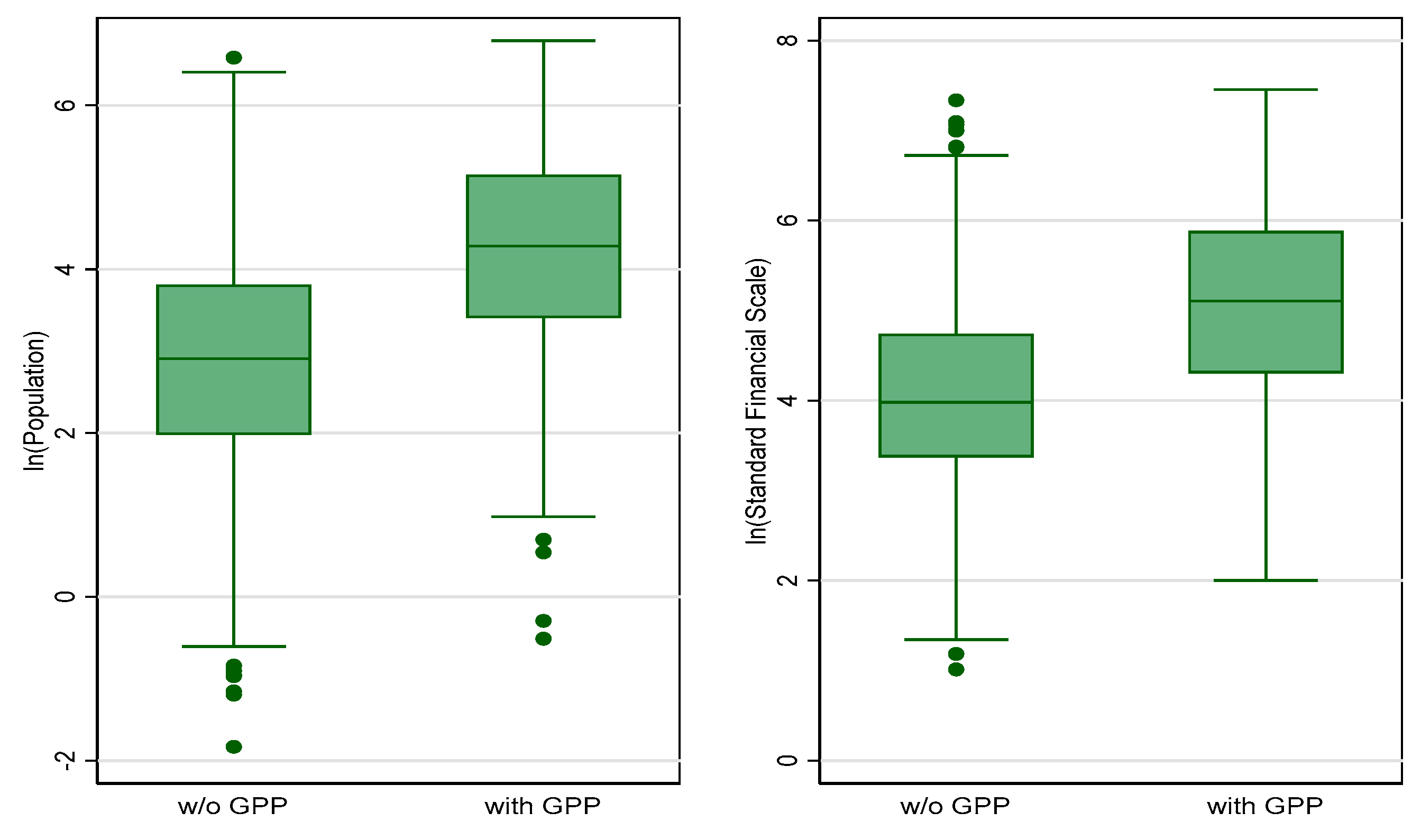
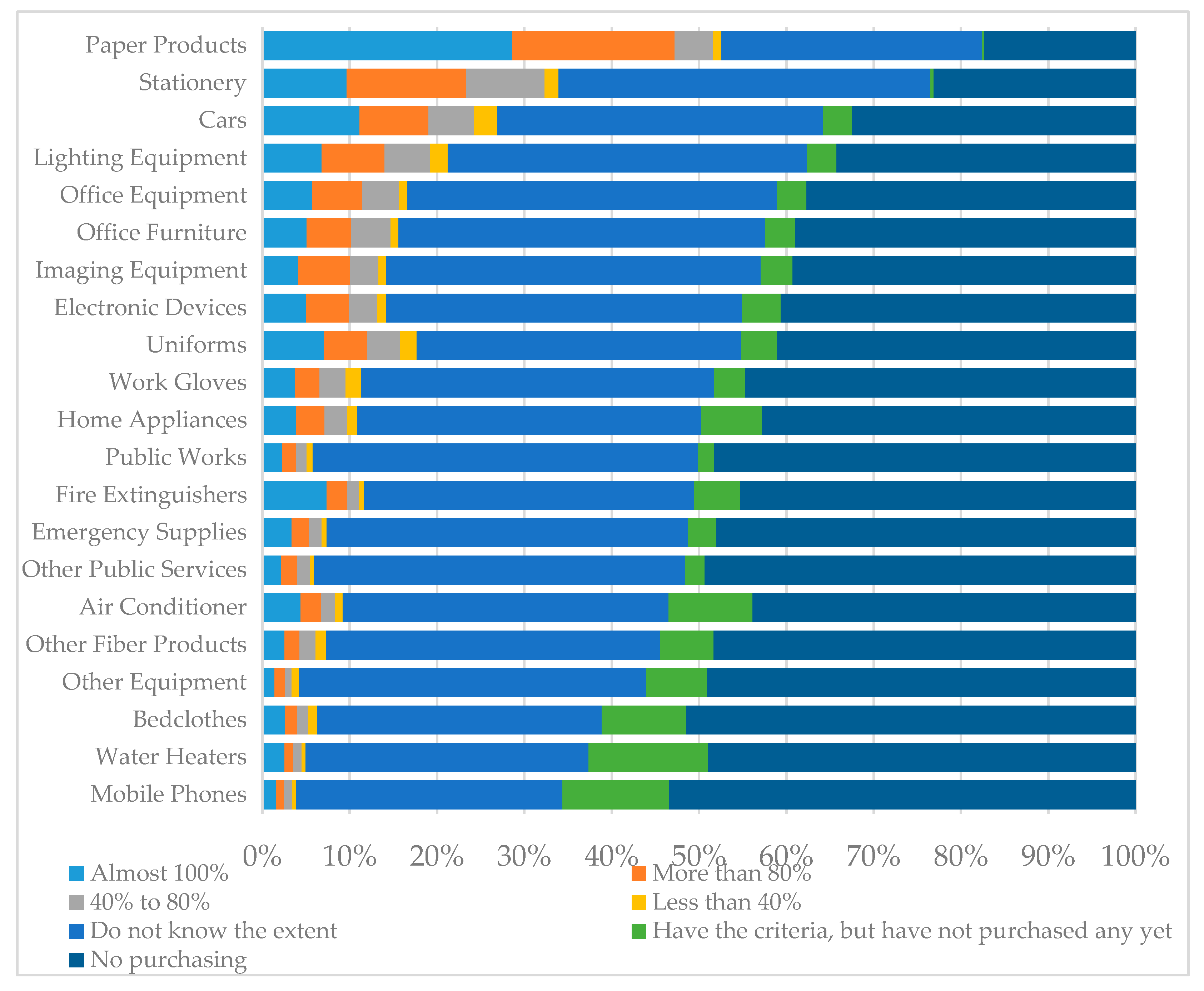
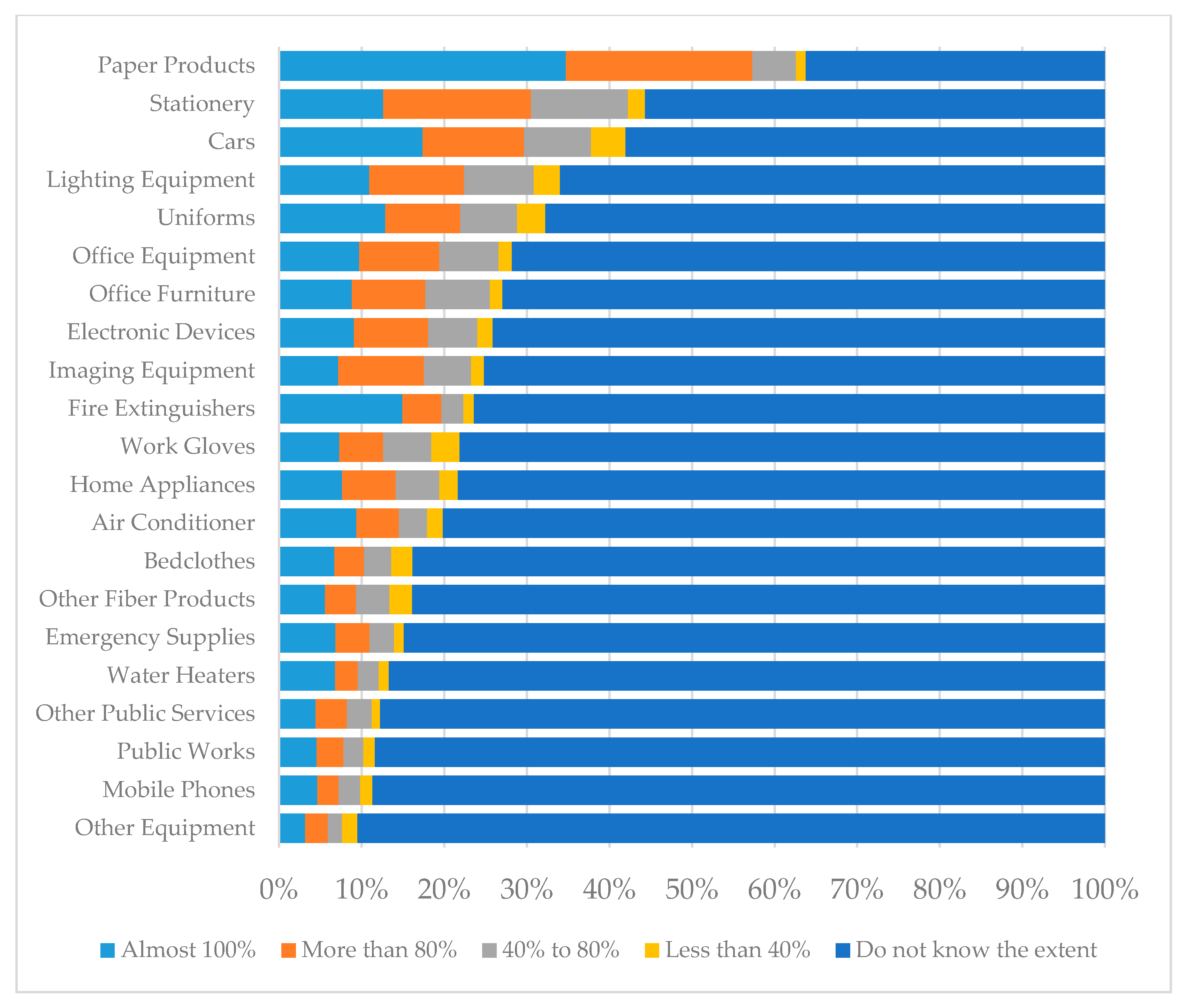
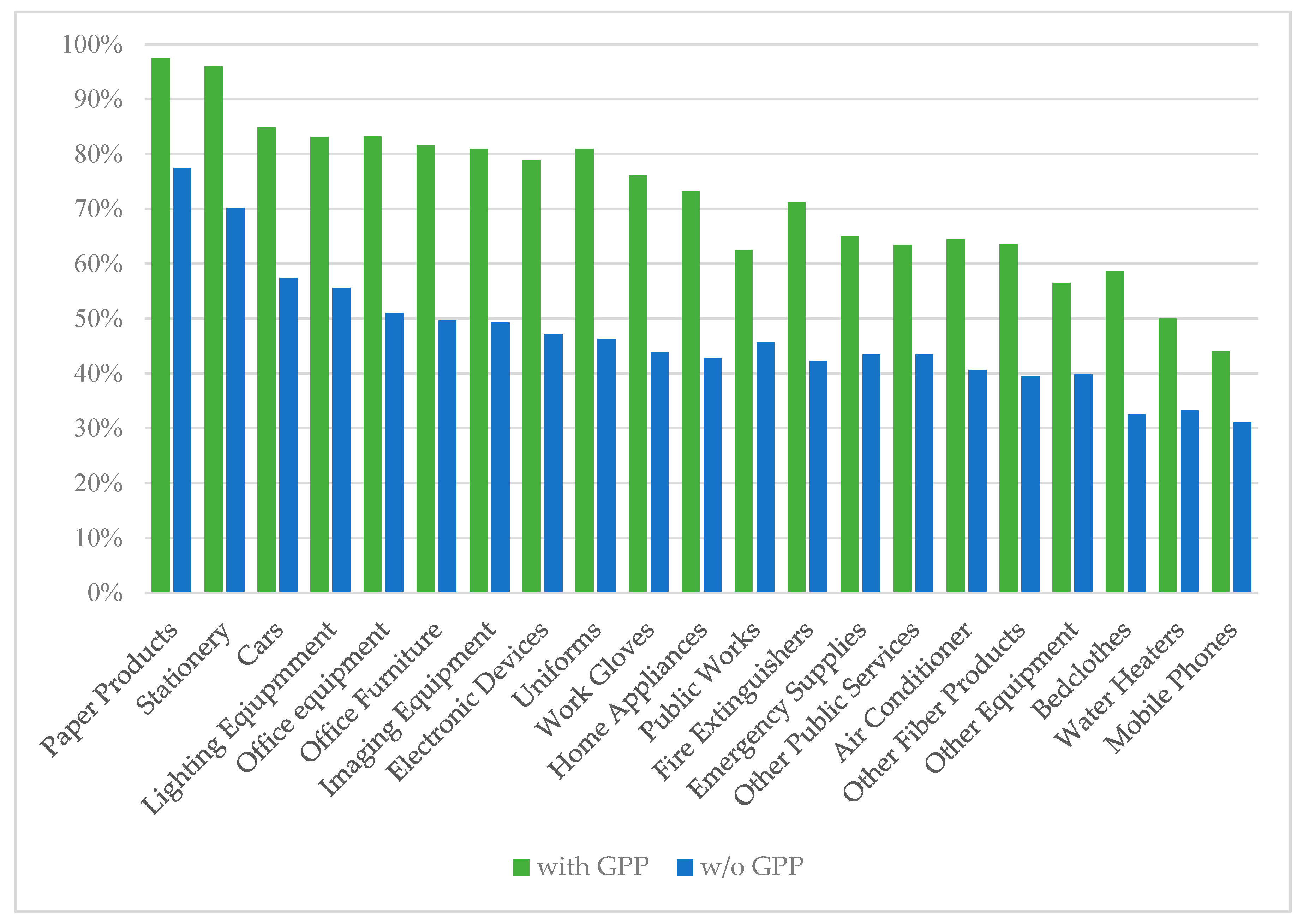
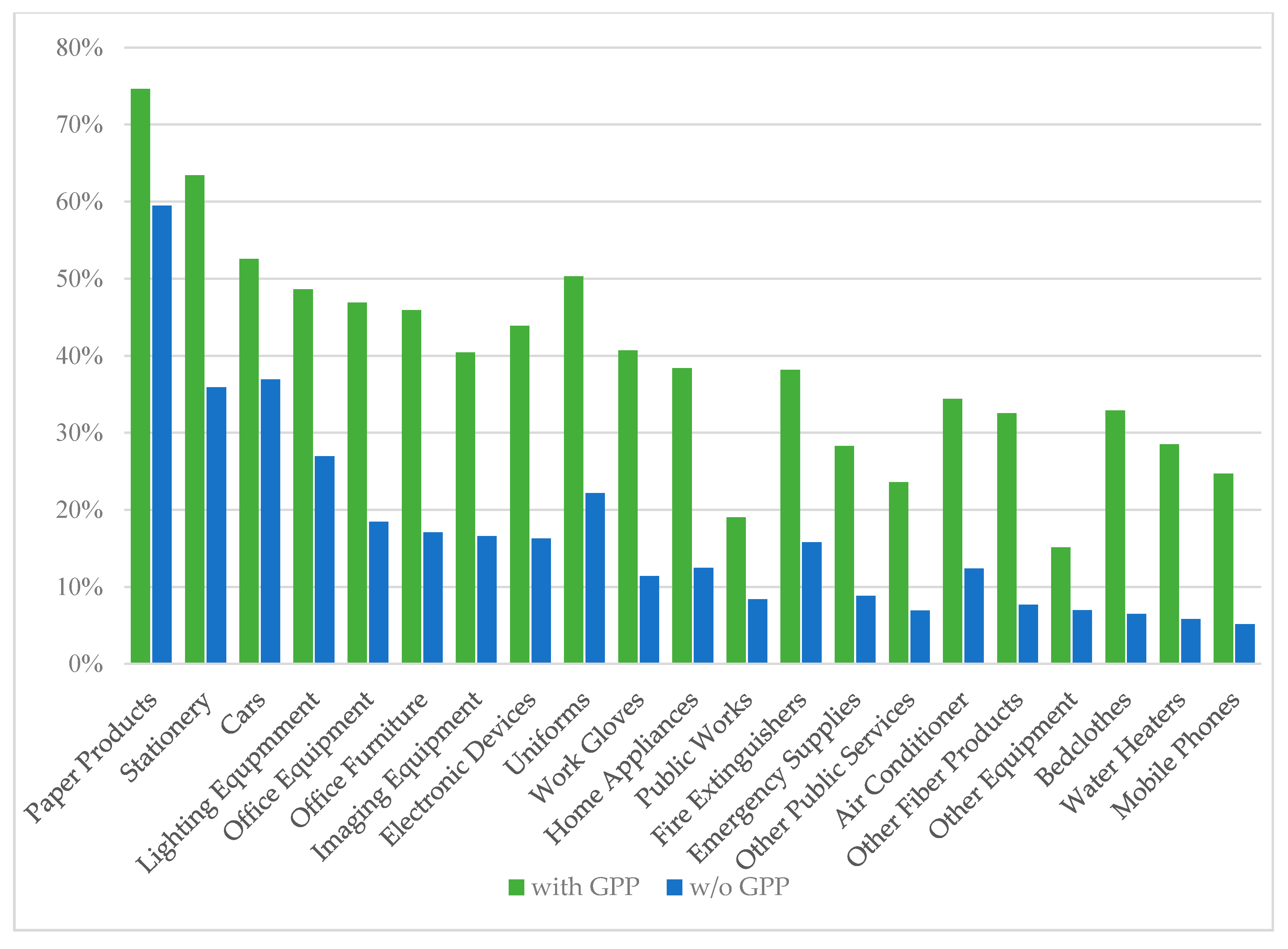
| (1) | (2) | |||
|---|---|---|---|---|
| Implementation of Green Purchasing | Municipality Measuring Its Own Green Purchasing Rate | |||
| Items | APE | N | APE | N |
| Paper Products | 0.14 *** (0.02) | 1602 | 0.12 *** (0.03) | 1335 |
| Stationery | 0.19 *** (0.02) | 1598 | 0.23 *** (0.03) | 1238 |
| Cars | 0.14 *** (0.03) | 1590 | 0.12 *** (0.04) | 1020 |
| Lighting Equipment | 0.15 *** (0.03) | 1595 | 0.20 *** (0.04) | 994 |
| Office Equipment | 0.19 *** (0.03) | 1585 | 0.28 *** (0.04) | 933 |
| Office Furniture | 0.17 *** (0.03) | 1592 | 0.25 *** (0.03) | 916 |
| Imaging Equipment | 0.18 *** (0.03) | 1583 | 0.22 *** (0.04) | 903 |
| Electronic Devices | 0.18 *** (0.03) | 1578 | 0.26 *** (0.04) | 854 |
| Uniforms | 0.18 *** (0.03) | 1582 | 0.20 *** (0.04) | 867 |
| Work Gloves | 0.17 *** (0.03) | 1585 | 0.28 *** (0.04) | 777 |
| Home Appliances | 0.14 *** (0.03) | 1585 | 0.20 *** (0.04) | 772 |
| Fire Extinguishers | 0.12 *** (0.03) | 1579 | 0.19 *** (0.04) | 758 |
| Emergency Supplies | 0.09 *** (0.03) | 1582 | 0.20 *** (0.04) | 719 |
| Public Works | 0.04 (0.03) | 1585 | 0.12 *** (0.04) | 676 |
| Other Public Services | 0.06 ** (0.03) | 1580 | 0.17 *** (0.04) | 652 |
| Air Conditioners | 0.06 ** (0.03) | 1578 | 0.16 *** (0.04) | 701 |
| Other Equipment | 0.03 (0.03) | 1574 | 0.12 *** (0.04) | 533 |
| Other Fiber Products | 0.08 ** (0.03) | 1573 | 0.22 *** (0.04) | 659 |
| Bedclothes | 0.09 *** (0.03) | 1568 | 0.23 *** (0.04) | 503 |
| Water Heaters | 0.01 (0.03) | 1567 | 0.23 *** (0.04) | 454 |
| Mobile Phones | −0.02 (0.03) | 1565 | 0.21 *** (0.05) | 424 |
Publisher’s Note: MDPI stays neutral with regard to jurisdictional claims in published maps and institutional affiliations. |
© 2020 by the authors. Licensee MDPI, Basel, Switzerland. This article is an open access article distributed under the terms and conditions of the Creative Commons Attribution (CC BY) license (http://creativecommons.org/licenses/by/4.0/).
Share and Cite
Miyamoto, T.; Yajima, N.; Tsukahara, T.; Arimura, T.H. Advancement of Green Public Purchasing by Category: Do Municipality Green Purchasing Policies Have Any Role in Japan? Sustainability 2020, 12, 8979. https://doi.org/10.3390/su12218979
Miyamoto T, Yajima N, Tsukahara T, Arimura TH. Advancement of Green Public Purchasing by Category: Do Municipality Green Purchasing Policies Have Any Role in Japan? Sustainability. 2020; 12(21):8979. https://doi.org/10.3390/su12218979
Chicago/Turabian StyleMiyamoto, Takuro, Naonari Yajima, Takahiro Tsukahara, and Toshi H. Arimura. 2020. "Advancement of Green Public Purchasing by Category: Do Municipality Green Purchasing Policies Have Any Role in Japan?" Sustainability 12, no. 21: 8979. https://doi.org/10.3390/su12218979
APA StyleMiyamoto, T., Yajima, N., Tsukahara, T., & Arimura, T. H. (2020). Advancement of Green Public Purchasing by Category: Do Municipality Green Purchasing Policies Have Any Role in Japan? Sustainability, 12(21), 8979. https://doi.org/10.3390/su12218979




